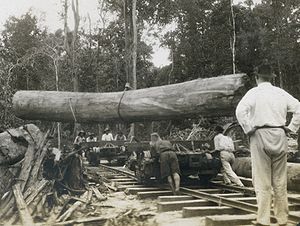The famous author Agnes Newton Keith, who wrote Land Below the Wind and other books about her life in Sandakan, was married to Harry Keith, Conservator of Forests for North Borneo (now Sabah, Malaysia).

Harry was a dedicated official and passionate about the need to sustainably manage North Borneo’s forest reserves. The British North Borneo (Chartered) Company, which was running the territory at the time, derived the bulk of its income from the sale of logging permits. No doubt Borneo’s vast forestry reserves seemed inexhaustible but even as early as the 1940s, Harry could see that continued rampant logging activity was not sustainable.
Despite his best efforts however you would have to conclude that he and his successors ultimately failed in their role as conservators of forests because Sabah today is pretty much logged-out.
How can that be you might ask? Isn’t it true that 48.8% of Sabah’s total land area (7,362,000 ha) is classified as Forest Reserve? That is true but of that total, only 342,216 ha (4.6% of Sabah’s total land area) is classed as Protection Area in which logging is not permitted. A further 90,386 ha (1.22%) is considered as Virgin Jungle Forest where logging is strictly prohibited but in practice illegal logging has taken place. The majority of the Forest Reserve is categorized as Production Forest and can be, and has been, ‘selectively logged’ under licence.
This WWF graphic illustrates what is happening all over Borneo. (Sabah is in the top right corner.)
When Harry Keith retired in 1950, North Borneo’s forest cover was still fairly intact but by the 1980s logging was at its peak and Sabah was exporting 12 million cubic metres of timber per year, much of it to Japan to be turned into plywood and disposable chopsticks. Presumably the remains are now lying rotting in Japanese landfills. An ignoble end to once mighty trees!
Some trees have fared better. It is said that logs from Sandakan were used in the construction of the Temple of Heaven in Beijing.
By the early 2000s, Sabah’s timber exports had dwindled significantly mainly due to depletion of forests and Japanese and other lumber trading firms had moved on to new sources like Papua New Guinea.
I do not wish to sound too gloomy. Forests can recover. If all humans left Sabah tomorrow the jungle would return to its former glory in 250 years or so. But that is too long a time horizon for businesses to consider and as for politicians, they know that future generations do not have a vote so who cares if their world is wrecked?
As for the future of wild animals, I’m afraid I am very pessimistic. They are doomed. Already they are virtually extinct outside of zoos and wildlife parks, not just in Borneo but all over the developing world. The only creatures which can thrive in today’s overcrowded world are rats, cockroaches, flies and ants.
Organizations like WWF are wasting their time. The battle for pandas, tigers, elephants, rhinos and the like is lost. Instead WWF should turn its attention to tackling the source of this and so many other problems, and that is global over-population. This is a glaring issue but no governments, apart from China’s, seem willing to do anything about it. On the contrary, many countries are actively encouraging their citizens to have more children.
In my view the United Nations should set a target to half the world’s population over the next 100 years or so. Every country should adopt a One is Enough child policy and use a combination of incentives and deterrents to achieve it such as:
- removal of child benefits
- free or subsidised schooling for first child only
- lower income tax for those couples with only one child or no children
Ok, I admit I am being hypocritical here as I have three children but I have only recently become convinced that having a smaller world population would solve so many of the problems facing the planet. I’ll encourage my children to have one or less kids.




“Temple of Heaven” had been made long before early 1900. How can you link it between 1950 & Mr. Harry Keith. Have you really visit and ever seen Sabah (North Borneo) reserved log forests.
Hi,thanks for commenting. I was not trying to link the Temple of Heaven with the 1950s or Mr. Keith, I was just pointing out the interesting fact that logs from Borneo were said to have been used in its construction, a fact supported by the North Borneo Historical Society. Yes, I have seen seen some Sabah reserved log forests and I plan to see more. What is your point? Are you perhaps suggesting that I am being too negative about the deforestation of Borneo? If you have a different opinion you are welcome to share it here.